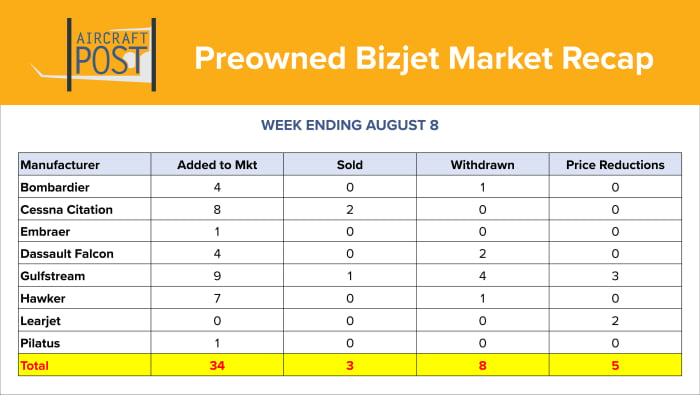
Global business aircraft flight activity climbed 3.7% year over year (YOY) in July, with the North America region alone matching that gain, according to the latest TraqPak report from industry analyst Argus International. Europe, meanwhile, experienced its third consecutive YOY increase in July, up 1.8%. With that momentum, Argus expects flight activity this month in North America to be up 2% and in Europe by 0.2% YOY.
In North America during July, all operational categories saw gains, with fractionals continuing to lead the charge, up 8.6% YOY. Part 135 activity rose by 1.3%, while Part 91 flying increased by 3.7%, mirroring the global and North America-specific gains. By aircraft category, light jets led for the third month in a row, rising 5.4% YOY in July, followed by turboprops, +4.4%; large jets, +4.3%; and midsize jets, +1.4%.
In Europe, large-cabin jets notched the strongest improvement, up 6.6% YOY in July, followed by midsize jets at 3.4%. However, turboprop and light-jet activity were on the negative side, down by 3.5% and 1.3%, respectively.
Other regions of the world combine for a 5.5% increase, with light jets marking the most notable jump with an 18.4% increase. This was followed by large-cabin jets, which were up 7.9%. Midsize jets and turboprops came in with 2.3% and 2.1% improvements, respectively.
|
A pilot’s response to receiving a letter from the FAA’s Aerospace Medicine Certification Division (AMCD) can be wide-ranging. If the pilot had been anxiously waiting for a letter from the FAA in response to a medical application previously submitted, the initial joy of it finally arriving is also fraught with trepidation upon opening it—will it be an approval or a denial?
If an FAA letter was entirely unexpected, a pilot’s initial reaction will always be that of dread. What horrors are contained within?
The purpose of this discussion is to help pilots read between the proverbial lines. There is typically a moderate degree of confusion when reading an FAA letter. They are full of government legalese, referring to all sorts of FARs and Code of Federal Regulations (CFRs). That is confusing enough.
After that, there are often threatening-sounding bold-faced warnings and other considerations that do nothing to allay a pilot’s fears. There are many times when a pilot is unsure if they are formally grounded and whether anything needs to be done immediately to defuse the situation.
In my usual overly-optimistic AME fashion, I am pleased to report that the majority of FAA letters to pilots do not ground the pilot. I do not dismiss how stressful it can be for pilots to receive FAA letters, but usually they present a situation that is not insurmountable.
|
Aviation services drove Berkshire Hathaway’s service group revenues up $466 million (8.9%) in the second quarter and $808 million (7.8%) in the first six months versus the same period last year. The services division includes fractional-share and charter operator NetJets and aviation training provider FlightSafety International.
Breaking out the aviation revenues, the company reported 9.6% growth year-to-date. This was attributable to “increases in the number of aircraft in shared aircraft ownership programs and in-flight hours across NetJets’ various programs and higher average rates.” This was “partially offset by higher flight crew costs and higher maintenance, fuel, and depreciation expenses,” the company reported.
“Service group pre-tax earnings increased $96 million (up 15.2%) in the second quarter and $153 million (up 12.5%) in the first six months of 2025 compared with 2024, primarily attributable to increases from aviation services, TTI, the leasing businesses, and Charter Brokerage.” TTI is an electronic components distributor, while Charter Brokerage provides logistics services for the petroleum and chemical industries.
|
APP Jet Center inaugurated the newest hangar at its Stuart Jet Center FBO at Florida’s Witham Field Airport (KSUA) this week with a ribbon-cutting ceremony attended by employees, customers, airport officials, and local dignitaries.
The 20,000-sq-ft hangar, which can accommodate ultra-long-range business jets, took a year to build and is fully leased. It includes 4,000 sq ft of executive office space on the second floor and brings the company to 140,000 sq ft of hangar and office space at KSUA.
South Florida remains one of the most active private aviation markets in the country. According to APP, demand for widebody, high-tail aircraft storage and top-tier office space continues to rise. Across its network of four FBOs—in Fort Pierce, Florida (KFPR); Manassas, Virginia (KHEF); Hayward, California (KHWD); and KSUA, as well as its hangar complex at Denver-area Centennial Airport (KAPA)—APP now manages more than one million sq ft of hangar space in the U.S.
“There is high demand for hangar space in business and general aviation, and we are expanding our real estate offering at each of the airports we serve,” said APP Jet Center CEO Dan Harrow. “While we’ve grown considerably in the last few years, we’ve kept our small, family-owned business culture, and we take the needs of each local aviation community into consideration with every new build.”
|
Quiet Technology Aerospace (QTA) recently delivered its 600th inlet cowl and is adding 10,000 sq ft to its existing 30,000-sq-ft manufacturing facility in Hollywood, Florida. The composite QTA inlet cowls come with a lifetime transferable warranty and solve the problem of corrosion of turbine engine inner barrels, disbonding of the acoustic mesh, and engine ingestion of loose material.
Inlet upgrades are available for the Bombardier Challenger 300, 350, and 3500, and Learjet 60/60XR; Gulfstream G200, G280, and G450; Embraer Legacy 450/500 and Praetor 500/600; Textron Aviation Cessna Citation Longitude and Hawker 1000; and Dassault Falcon 2000EX/LX series. QTA can exchange inlet cowls for these airplanes or upgrade the customer’s inlets.
The company has also developed upgraded thrust reversers for Honeywell HTF7000-powered business jets. These “replace the original corroding aluminum structures with titanium components that are more durable and entirely corrosion-resistant, significantly reducing long-term maintenance costs for operators,” according to QTA. There is no impact on engine performance because the new reverser “exactly matches the inner mold line and exit area of the original thrust reverser.”
“This achievement is a testament to the strength of our engineering and manufacturing teams and to the continued confidence that operators place in our products,” said QTA CEO Barry Fine. “We’re honored to support the performance and longevity of aircraft across a wide range of platforms.”
|
Top Stories This Week on AINonline
|

Photo of the Week
Viva la LABACE. The 2025 edition of the Latin American Business Aviation Convention and Exhibition concluded yesterday, drawing a steady stream of aircraft operators and potential buyers. For the first time in its 22-year history, the São Paulo show was held at a new venue—Campo de Marte Airport—which offered much more space than its previous home at Congonhas Airport. Photo by AIN contributor Richard Pedicini.
Keep them coming. If you’d like to submit an entry for Photo of the Week, email a high-resolution horizontal image (at least 2000 x 1200 pixels), along with your name, contact information, social media names, and info about it (including brief description, location, etc.) to photos@ainonline.com. Tail numbers can be removed upon request. Those submitting photos give AIN implied consent to publish them in its publications and social media channels.
|
AINalerts News Tips/Feedback:
News tips may be sent anonymously, but feedback must
include name and contact info (we will withhold name on request). We reserve the
right to edit correspondence for length, clarity, and grammar. Send feedback or
news tips to AINalerts editor Chad Trautvetter.
|
AINalerts is a publication of AIN Media Group, 214 Franklin Avenue, Midland Park, New Jersey. Copyright 2025. All rights reserved.
Reproduction in whole or in part without permission is strictly prohibited.
|
|














